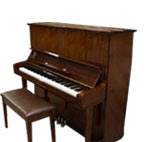1816
Joseph Mohr creates the text to “Silent Night!” in the form of a poem in Mariapfarr in the Lungau region where he was living at the time.
1818
In the schoolhouse of Arnsdorf, on Christmas Eve, Franz Xaver Gruber composes a melody to fit the text.
1818
“Silent Night! Holy Night!” has its world premiere on Christmas Eve in the St. Nicholas church of Oberndorf near Salzburg, performed by Franz Xaver Gruber and Joseph Mohr
FIRST PERFORMANCE – OBERNDORF, 1818
“It was the 24th of December of the year 1818, when the then assistant priest Joseph Mohr at the newly established parish of St. Nicholas in Oberndorf handed over to the organist represented by Franz Gruber (who at the time was also school teacher in Arnsdorf) a poem, with the request to write a fitting melody for 2 solo voices together with choir and for accompaniment by guitar.” These are the words of Franz Xaver Gruber which he wrote on December 30, 1854 in his “Authentic Account of the Origin of the Christmas Carol, ‘Silent Night, Holy Night!'” Later the same day, on the 24th of December, Gruber came to the musically talented Mohr and handed over to him his composition. As Mohr liked what he saw, this song was included in the Christmas mass that evening. Mohr sang the tenor part and provided accompaniment with guitar, while Gruber sang bass. According to Gruber, the song was met with “general approval by all” in attendance (mostly shipping laborers, boat builders and their families).
In Gruber’s “Authentic Account,” there is no mention of the specific inspiration for creating the song. One supposition is that the church organ was no longer working, so that Mohr and Gruber therefore created a song for accompaniment by guitar. Surrounding this premiere performance of “Silent Night!” many romantic stories and legends have been written adding their own anecdotal details to the known facts
TEXT OF THE SONG – MARIAPFARR, 1816
We now know that Mohr created the text to the song already in 1816 during the time he served as an assistant priest in Mariapfarr in Lungau. The score autographed by Mohr which was discovered in 1995 – the only extant one autographed by Mohr – attests to the date of creation for the text. In the lower left is written: “Text von Joseph Mohr mpia Coadjutor 1816” (“Text by Joseph Mohr – confirmed by my own signature – assistant priest 1816”). After careful study by historians, it is estimated that this autograph was written between 1820 and 1825, while the “1816” after Mohr’s name is believed to refer to the year in which Mohr created the text. This autographed score also provides a key statement in the upper right: “Melodie von Fr. Xav. Gruber” (“Melody by Fr. Xav. Gruber”) and therewith clarifies conclusively the question many have asked over the years as to which man actually composed the melody to the song.
HISTORICAL CONTEXT
“Silent Night!” was created and first performed during very difficult times. The Napoleonic wars (1792-1815), which had caused great suffering, had come to an end. With the Congress of Vienna there were new borders and a new order set for Europe. In the course of these events, the ecclesiastical Principality of Salzburg lost its status as an independent country and was forced to secularize. In 1816, its lands were divided in two with part assigned to Bavaria and the larger portion relegated to Austria. The site where “Silent Night!” was first performed – Oberndorf by Salzburg – had been a suburb and was now separated from its town center of Laufen located across the river (today part of Bavaria, Germany) when the Salzach River became the new border. For centuries transportation of salt along the river had provided the basis for the local economy. The salt trade declined during the Napoleonic wars, and then never fully recovered. This caused a depression in the local economy, with the transport companies, boat builders and laborers facing unemployment and an unsure future. It was during these troubled times that Mohr was in Oberndorf (1817-1819).
Mohr’s previous place of service, Mariapfarr, had suffered greatly during the withdrawal of the Bavarian occupation troops in 1816 and 1817. Mohr was witness to these events and in 1816, he wrote the words to “Silent Night!” With this in mind, the creation of the 4th verse of “Silent Night!” takes on special meaning. Its text expresses a great longing for peace and comfort.










